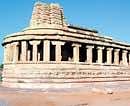

In the vast plains of Northern Karnataka on the banks of the Malaprabha river are scattered ancient temples that played a major role in the evolution of temple architecture in South India. Around the village of Aihole are structures of stone in various shapes and sizes dating back to the sixth century and later, that refuse to conform to any specific style of temple construction. With students of those days arriving from every corner to learn and master the art of carving in stone here, historians have often called Aihole the ‘cradle of Indian architecture.’
The first thing that attracts the visitor in Aihole is the well-maintained main enclosure of temples in the centre of the village. Taking a tour of the large Lad Khan Temple and well-known Durgi Gudi that has parallels with the Parliament building in its façade, I heard my guide talk about a number of smaller temples scattered around the village. With his guidance, I went in search of these ancient structures that seemed to be visited by very few people.
Most of these temples are built between sixth and 12th century CE in two phases. The older temples are attributed to Chalukyas till the time King Pulikeshi II moved his capital to nearby Badami. The later structures were built by Rashtrakootas who ruled the region after Badami Chalukyas.
Among the oldest of these temples is Ravan phadi, dating back to the latter half of the sixth century. It is a small rock-cut room with a linga in the centre and beautiful carvings on the inner side walls. To one side is a statue of Nataraja holding a serpent in his hands, flanked by Lord Ganesha and his associates. Ravanphadi is one of the earliest examples of rock-cut constructions in South India.
Huchimalli temple
To the west of Ravanphadi is Huchimalli temple built in a more formal nagara style of architecture. The temple stands alone in an enclosure far away from other monuments, with its shrine visible from a distance. The entry to the temple is through a small mantapa one can reach by a flight of steps. The walls of the temple are plain, but the tapering shrine has intricate designs, capped by a gooseberry like amalaka that forms the shikhara, typical to temples built in nagara style. Seen from anywhere in Aihole is the Meguti Temple located at the top of a hill. Standing next to the Meguti Temple, I can see the entire village dotted with ancient temples in all directions and the river Malaprabha flowing at the edge of the hamlet. Located at Meguti Temple is an epigraph popularly known as ‘Aihole inscription’ that has provided clues to many historical events during the times of Chalukyan rule.
The inscription is written in Sanskrit using the Kannada script. Apart from mentioning the complete lineage of Chalukya kings, it details the defeat of Harshavardhana in the hands of Pulikeshi II. It also mentions the victory of Chalukyas over Pallava kings and of Pulikeshi shifting the capital from Aihole to Badami. A mention of Kalidasa in the lettering provides historians with a rough clue about the timelines of the famed poet. Descending from the hill and walking through the dense pack of houses in the village, I discovered many small but ancient temples that appeared every now and then among the houses. These temples seem to be a hybrid of nagara and Dravidian architecture, though some did not seem to adhere to any specific style.
Walls, walls...
At the opposite end of the village is the enclosure of Galaganatha group of temples on the bank of the Malaprabha river. The complex of temples here appears like a random arrangement of walls restored by the Archaeological Survey of India, but a few ornate door frames indicate that this place once hosted architectural gems similar to anywhere else in Aihole.
The sandstone walls of the temple complex, the remains of some shrines and the pillared mantapas give one a feel of the village’s past. The structures in Aihole vary a great deal in shape and size, but in each of them can be found some element or the other that was used in the architectural styles of later periods. Although all elements of vesara architecture that was used by later Chalukyas and Hoysalas, characterised by a sanctum, a hall and a mantapa are seen only in a few temples of Aihole, each temple has one or the other element that seemed to have contributed to its evolution. The variety in construction indeed indicates that Aihole was a centre for early experiments in South Indian architectural styles.
Getting there
Aihole is an hour’s drive from Badami, the nearest town. Badami is about 505 km from Bangalore and is well connected by overnight KSRTC buses.
You can also reach Badami via Hubli, which is 130 kms away. Take a local bus or hire a private vehicle to get from Badami to Aihole. You can also stop at the UNESCO world heritage site of Pattadakal on the way.